Style
Witch Hazel Can Work Wonders On Greasy Hair, & Here's The Science Behind It

Witch hazel is one of those things you're guaranteed to find in your nan's medicine cabinet. Thought to be a calming product for a number of skin conditions, the North American plant extract can also work wonders on your barnet. Figuring out exactly how to use witch hazel on your hair, however, can take some trial and error.
The shrub has a lengthy medical history. As Healthline explains, the medicinal extract comes specifically from the leaves and bark of a plant called Hamamelis virginiana. Traditionally used by the Native American community as a treatment for small wounds and inflammatory skin problems, witch hazel (and its powerful antioxidant contents) can now be found in a ton of skincare products, reports The Atlantic.
But it is slowly entering the hair world — mainly for its oil-reducing capabilities. You see, witch hazel falls into the 'astringent' category. These substances can cause bodily tissues to shrink in size, making them ideal for people who want a pore-tightening effect.
A similar result can be seen on the head. If you're constantly stressing that your scalp is too oily or greasy, witch hazel may be able to help, reports Medical News Today. Healthline adds that the ingredient can also relieve itchiness, feelings of sensitivity, and other scalp issues including dryness and dandruff.
A 2014 study on 1,373 people found a witch hazel-based shampoo effective in helping irritation. However, there is little evidence — aside from individual stories — to back up any of the other claims. Deciding whether to try it out is a personal choice. Just ensure you do a patch test 24 hours prior to check for any signs of an allergic reaction.
One dermatologist has issued a warning to the witch hazel-intrigued. "Some astringents like witch hazel and calamine are known to soothe skin because of their anti-inflammatory properties," he told Allure. "However, some patients get very dry after applying it, which in itself can be a stimulant for itching." He therefore recommends avoiding the substance if you don't have oily hair.
There are several ways to apply witch hazel directly to your hair or scalp. You can douse a cotton pad in it, rubbing it onto your scalp in the shower and leaving for around 10 minutes. Afterwards, shampoo your hair as you normally would.
If you have a particularly sensitive scalp or are worried about the product being too strong, try diluting it with water. Without shampooing, gently pat it into the parting and hairline. Doing this no more than once or twice a week is advised.
A few well-known brands have infused witch hazel into their shampoos. Neal's Yard Remedies' Rejuvenating Geranium Shampoo won't strip away any essential natural oils, but claims to give shine back to oily hair types. Pureology's Purify Shampoo is designed specifically for dyed hair and promises to gently remove impurities while keeping colour looking its best.
Some beauty bloggers have even come up with their own witch hazel shampoo recipes. This concoction also includes aloe vera gel, jojoba oil, tea tree oil, and lavender oil and is described as a gentle cleansing formula. Obviously, these formulas won't have had expert input, so proceed with caution.
And that statement applies to any new skin or haircare ingredient you try. Remember: everyone's body reacts differently and what works for one person may not work for you.